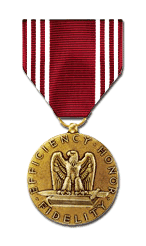
Establishing Authority
The Army Good Conduct Medal was established by Executive Order 8809 signed by President Franklin D. Roosevelt on June 28, 1941.
Effective Dates
The Army Good Conduct Medal has been awarded to enlisted members of the Army for qualifying service from August 26, 1940 to the present.
Criteria
The Army Good Conduct Medal is awarded on a selective basis to enlisted members of the Army who distinguish themselves by exemplary behavior, efficiency and fidelity during a specified period of continuous enlisted active service (normally three years in peacetime).
Order of Precedence
The Army Good Conduct Medal is worn after the Prisoner of War Medal and before the Army Reserve Components Achievement Medal.
Devices
Additional awards are indicated by a clasp 1/8 inch wide and 1 and 3/8ths of an inch long. They are awarded in bronze, silver, and gold according to the following scheme:
- Second Award: Bronze clasp with 2 loops
- Third Award: Bronze clasp with 3 loops
- Fourth Award: Bronze clasp with 4 loops
- Fifth Award: Bronze clasp with 5 loops
- Sixth Award: Silver clasp with 1 loop
- Seventh Award: Silver clasp with 2 loops
- Eighth Award: Silver clasp with 3 loops
- Ninth Award: Silver clasp with 4 loops
- Tenth Award: Silver clasp with 5 loops
- Eleventh Award: Gold clasp with 1 loop (and so on)
Designer
The Army Good Conduct Medal was designed by Joseph Kiselewski.
Description and Symbolism
Obverse
In the center of a bronze medallion one and a quarter inches in diameter, an eagle is shown with its wings displayed while standing on a closed book and Roman sword, encircled by the words EFFICIENCY HONOR FIDELITY.
The eagle is the American bald eagle and represents the United States. The closed book and Roman sword allude to military strength through training and knowledge. The inscription describes the virtues which this medal seeks to reward.
Reverse
In the center of a bronze medallion one and a quarter inches in diameter, there is a five-pointed star and scroll between the words FOR GOOD CONDUCT, surrounded by a wreath formed by a laurel branch on the left and an oak branch on the right.
The five-pointed star is taken from the Union of the Nation's flag and represents each State and all of them collectively and is also the symbol of military service. The scroll is provided for inscription of the recipient's name. The laurel branch is symbolic of achievement and the oak branch represents both strength and courage.
Ribbon
The ribbon was designed by Arthur E. DuBois and is red with three white pinstripes inside each edge. The use of red was based on the color of the Navy's Good Conduct Medal, with the white stripes added to make it distinctive.